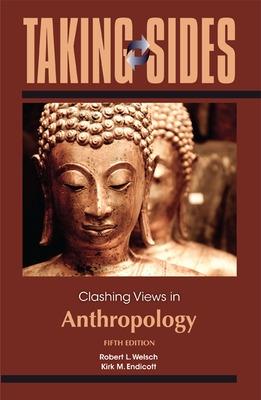Taking Sides: Clashing Views in Anthropology
 portes grátis
portes grátis
Taking Sides: Clashing Views in Anthropology
Endicott, Kirk; Welsch, Robert
McGraw-Hill Education - Europe
04/2012
480
Mole
Inglês
9780078050343
15 a 20 dias
499
Is Race a Useful Concept for Anthropologists?
YES: George W. Gill, from "Does Race Exist? A Proponent's Perspective," NOVA Online, 2000
NO: C. Loring Brace, from "Does Race Exist? An Antagonist's Perspective," NOVA Online, 2000
Biological and forensic anthropologist George Gill argues that the concept of race is useful because races-conceived of populations originating in particular regions-can be distinguished by combinations of external and skeletal features. The concept of race is especially useful for the forensic task of identifying human skeletons. The notion of race also provides a vocabulary for discussing human biological variation and racism that can be understood by students. Biological anthropologist C. Loring Brace argues that distinct races cannot be defined because human physical features vary gradually (in clines) and independently from region to region, without sharp discontinuities between physical types. He says races exists in people's perceptions but not in biological reality. In his view the peculiar historical pattern in which Native Americans, Africans brought to the United States as slaves, and European immigrants largely from northern Europe artificially makes it seem that these three groups form distinct races.
Are Humans Inherently Violent?
YES: Richard Wrangham and Dale Peterson, from Demonic Males: Apes and the Origins of Human Violence, Houghton Mifflin Harcourt Publishing Company, 1996
NO: Robert W. Sussman, from "Exploring Our Basic Human Nature: Are Humans Inherently Violent?" Anthro Notes, 1997
Biological anthropologist Richard Wrangham and science writer Dale Peterson maintain that male humans and chimpanzees, our closest nonhuman relatives, have an innate tendency to be aggressive and to defend their territory by violence. They state that sexual selection, a type of natural selection, has fostered an instinct for male aggression because males who are good fighters mate more frequently and sire more offspring than weaker and less aggressive ones. Biological anthropologist Robert W. Sussman rejects the theory that human aggression is an inherited propensity, arguing instead that violence is a product of culture and upbringing. He also rejects the contention that male chimpanzees routinely commit violent acts against other male chimps. Sussman regards the notion that human males are inherently violent as a Western cultural tradition, not a scientifically demonstrated fact.
Are Female Primates Selected to Be Monogamous?
YES: David M. Buss, from The Evolution of Desire: Strategies of Human Mating, Basic Books, 1994
NO: Carol Tavris, from The Mismeasure of Women, Simon and Schuster, 1992
Evolutionary psychologist David M. Buss draws on evolutionary theory to argue that humans like other primates have been shaped by evolution. For him, one key aspect of our evolutionary past is that male and female humans have evolved to have different evolutionary desires. Men desire multiple sexual partners, whereas females seek protection, security, and proven fertility in their mates. In this view, females favor monogamy and a stable relationship with the father of their children because such stability increases the likelihood of male investment in their children. Social psychologist Carol Tavris challenges the claims of sociobiologists and evolutionary psychologists that evolution has programmed women to seek monogamy. Suggesting that primate females have been selected for promiscuity, she argues that having multiple partners provides benefits for human females just as it might for males. The best evolutionary strategy for females is to get pregnant as quickly as possible, and having multiple partners is the quickest way to achieve this goal.
Unit: Archaeology
Did Humans Migrate to the New World from Europe in Early Prehistoric Times?
YES: Bruce Bradley and Dennis Stanford, from "The North Atlantic Ice-Edge Corridor: A Possible Palaeolithic Route to the New World," World Archaeology, 2004
NO: Lawrence Guy Straus, from "Solutrean Settlement of North America? A Review of Reality," American Antiquity, 2000
Archaeologists Bruce Bradley and Dennis Stanford maintain that there is no evidence that the ancestors of the Clovis big-game hunting people of North America originated in Siberia and migrated down an ice-free corridor from Alaska. They argue that Clovis stone tool technology probably developed among the Solutreans of Europe, and that these Solutrean hunters traveled across the North Atlantic ice sheet to North America, where they became the ancestors of the Clovis people. Archaeologist Lawrence Guy Straus counters that the Solutrean culture of Europe ended at least 5000 years before the Clovis culture appeared in the New World. He contends that the North Atlantic Ocean would have been an insurmountable barrier to human travel during the last glacial maximum. He argues that the similarities between the Clovis and Solutrean tool technologies are limited and coincidental.
Did Climate Change Rather Than Overhunting Cause the Extinction of Mammoths and Other Megafauna in North America?
YES: Donald K. Grayson and David J. Meltzer, from "A Requiem for North American Overkill," Journal of Archaeological Science, 2003
NO: Stuart Fiedel and Gary Haynes, from "A Premature Burial: Comments on Grayson and Meltzer's 'Requiem for Overkill'," Journal of Archaeological Science, 2004
Archaeologists Donald Grayson and David Meltzer argue that the evidence for human predation as the cause of the Pleistocene megafauna's extinction is circumstantial. They contend that this explanation is based on four premises that find little archaeological evidence to support them. Since there is limited evidence to support the overkill hypothesis, they suggest that climate change is a more likely explanation for these extinctions in North America as they seem to have been in Europe. Archaeologists Stuart Fiedel and Gary Haynes are strong supporters of the overkill hypothesis that argues that humans overhunted large mammals to extinction in North America. They contend that Grayson and Meltzer have misinterpreted older archaeological evidence and largely ignore more recent data. They maintain that there is little evidence for climate change as the cause of the extinctions, which happened within a relatively short period of about 400 years. They feel the empirical evidence supports the "overkill hypothesis."
Can Archaeologists Determine the Cultural Background of the Earliest Americans from the Ancient Skeleton Known as Kennewick Man?
YES: James C. Chatters, from "The Recovery and First Analysis of an Early Holocene Human Skeleton from Kennewick, Washington," American Antiquity, 2000
NO: Michelle D. Hamilton, from "Colonizing America: Paleoamericans in the New World," in Heather Burke, Claire Smith, Dorothy Lippert, Joe Watkins, and Larry Zimmerman, eds., Kennewick Man: Perspectives on the Ancient One, Left Coast Press, 2008
In 1997, biological anthropologist and archaeologist James Chatters set off a firestorm when he described one of the earliest skeletons found in North America as "Caucasoid-like," based on a very preliminary analysis of what has come to be known as Kennewick Man. Here, he provides a more thorough analysis and a much more cautious analysis of this same skeleton, finding that these remains are not similar to any modern Native American skeletons. He concludes that the 8000+ year old Kennewick skeleton, together with several other early skeletons, indicates that settlement of North America was not by a single Asian population, but a much more complex pattern of in-migration from multiple populations than most archaeologists and biological anthropologists have assumed. Forensic anthropologist Michelle Hamilton challenges Chatters's original description of the Kennewick skull as "Caucasoid." She argues that Chatters and others have subsequently backed away from this description in favor of a new model they have called the "Paleoamerican Paradigm." She contends that this new paradigm implies that the ancestors of modern Native Americans are not the first human settlers on the continent, much as in Chatters's original assessment. After considering the analysis of the Kennewick skull and Native American reactions to the entire controversy, she concludes that the strident approach by Chatters and his colleagues has increased tensions between archaeologists and Indians like no other event in the past 20 years.
Was There a Goddess Cult in Prehistoric Europe?
YES: Marija Gimbutas, from "Old Europe in the Fifth Millennium B.C.," in Edgar C. Polome, ed., The Indo-Europeans in the Fourth and Third Millennia, Karoma Publishers, 1982
NO: Lynn Meskell, from "Goddesses, Gimbutas, and 'New Age' Archaeology," Antiquity, 1995
Archaeologist Marija Gimbutas argues that the civilization of pre-Bronze Age "Old Europe" was matriarchal-ruled by women-and that the religion centered on the worship of a single great Goddess. Furthermore, this civilization was destroyed by patriarchal Kurgan pastoralists (the Indo-Europeans), who migrated into southeastern Europe from the Eurasian steppes in the fifth to third millennia B.C. Archaeologist Lynn Meskell considers the belief in a supreme Goddess and a matriarchal society in prehistoric Europe to be an unw
arranted projection of some women's utopian longings onto the past. She regards Gimbutas's interpretation of the archaeological evidence as biased and speculative.
Unit: Linguistic Anthropology
Can Apes Learn Language?
YES: E. S. Savage-Rumbaugh, from "Language Training of Apes," in Steve Jones, Robert Martin, and David Pilbeam, eds., The Cambridge Encyclopedia of Human Evolution, Cambridge University Press, 1999
NO: Joel Wallman, from Aping Language, Cambridge University Press, 1992
Psychologist and primate specialist E. S. Savage-Rumbaugh argues that, since the 1960s, there have been attempts to teach chimpanzees and other apes symbol systems similar to human language. These studies have shown that although apes are not capable of learning human language, they demonstrate a genuine ability to create new symbolic patterns that are similar to very rudimentary symbolic activity. Linguist Joel Wallman counters that attempts to teach chimps and other apes sign language or other symbolic systems have demonstrated that apes are very intelligent animals. But up to now these attempts have not shown that apes have any innate capacity for language.
Does Language Shape How We Think?
YES: John J. Gumperz and Stephen C. Levinson, from "Introduction: Linguistic Relativity Re-Examined," and "Introduction to Part 1," in John J. Gumperz and Stephen C. Levinson, eds., Rethinking Linguistic Relativity, Cambridge University Press, 1996
NO: Steven Pinker, from "Mentalese," in The Language Instinct: How the Mind Creates Language, 2000
Sociolinguists John Gumperz and Stephen C. Levinson contend that recent studies of language and culture suggest that language structures human thought in a variety of ways that most linguists and anthropologists had not believed possible. They argue that culture through language affects the ways that we think and the ways that we experience the world. Cognitive neuropsychologist Steven Pinker draws on recent studies in cognitive science and neuropsychology to suggest that Edward Sapir and Benjamin Whorf were wrong when they suggested that the structure of any particular language had any effect on the ways human beings thought about the world in which they lived. He argues that previous studies have examined language but have said little, if anything, about thought.
Is Black American English a Separate Language from Standard American English, with Its Own Distinctive Grammar and Vocabulary?
YES: Ernie Smith, from "What Is Black English? What Is Ebonics?" in Theresa Perry and Lisa Delpit, eds., The Real Ebonics Debate: Power, Language, and the Education of African-American Children, Beacon Press, 1998
NO: John H. McWhorter, from "Wasting Energy on an Illusion," The Black Scholar, 2001
Linguist Ernie Smith argues that the speech of many African Americans is a separate language from English because its grammar is derived from the Niger-Congo languages of Africa. Although most of the vocabulary is borrowed from English, the pronunciations and sentence structures are changed to conform to Niger-Congo forms. Therefore, he says, schools should treat Ebonics-speaking students like other non-English-speaking minority students. Linguist John McWhorter counters that Black English is just one of many English dialects spoken in America that are mutually intelligible. He argues that the peculiar features of Black English are derived from the dialects of early settlers from Britain, not from African language. Because African American children are already familiar with Standard English, he concludes, they do not need special language training.
Unit: Cultural Anthropology
Should Cultural Anthropology Stop Trying to Model Itself as a Science?
YES: Clifford Geertz, from "Thick Description: Toward an Interpretive Theory of Culture," in The Interpretation of Cultures: Selected Essays, 1973
NO: Robert L. Carneiro, from "Godzilla Meets New Age Anthropology: Facing the Postmodernist Challenge to a Science of Culture," EUROPEA, 1995
Cultural anthropologist Clifford Geertz views anthropology as a science of interpretation, and he argues that anthropology should never model itself on the natural sciences. He believes that anthropology's goal should be to generate deeper interpretations of cultural phenomena, using what he calls "thick description," rather than attempting to prove or disprove scientific laws. Cultural anthropologist Robert Carneiro argues that anthropology has always been and should continue to be a science that attempts to explain sociocultural phenomena in terms of causes and effects rather than merely interpret them. He criticizes Geertz's cultural interpretations as arbitrary and immune to disconfirmation.
Was Margaret Mead's Fieldwork on Samoan Adolescents Fundamentally Flawed?
YES: Derek Freeman, from Margaret Mead and Samoa: The Making and Unmaking of an Anthropological Myth, Harvard University Press, 1983
NO: Lowell D. Holmes and Ellen Rhoads Holmes, from "Samoan Character and the Academic World," in Samoan Village: Then and Now, 2nd ed., Harcourt Brace Jovanovich College Publishers, 1992
Social anthropologist Derek Freeman argues that Margaret Mead was wrong when she stated that Samoan adolescents had sexual freedom. He contends that Mead went to Samoa to prove anthropologist Franz Boas's cultural determinist agenda and states that Mead was so eager to believe in Samoan sexual freedom that she was consistently the victim of a hoax perpetrated by Samoan girls and young women who enjoyed tricking her. He contends that nearly all of her conclusions are spurious because of biases she brought with her and should be abandoned. Cultural anthropologists Lowell Holmes and Ellen Holmes contend that Margaret Mead had a very solid understanding of Samoan culture in general. During a restudy of Mead's research, they came to many of the same conclusions that Mead had reached about Samoan sexuality and adolescent experiences. They accept that Mead's description of Samoan culture exaggerates the amount of sexual freedom and the degree to which adolescence in Samoa is carefree but these differences, they argue, can be explained in terms of changes in Samoan culture since 1925 and in terms of Mead's relatively unsophisticated research methods compared with field methods used today.
Do Men Dominate Women in All Societies?
YES: Steven Goldberg, from "Is Patriarchy Inevitable?" National Review, 1996)
NO: Kirk M. Endicott and Karen L. Endicott, from "Understanding Batek Egalitarianism," in The Headman Was a Woman: The Gender Egalitarian Batek of Malaysia, Waveland Press, 2008
Sociologist Steven Goldberg contends that in all societies' men occupy most high positions in hierarchical organizations and most high-status roles, and they also tend to dominate women in interpersonal relations. He states that this is because men's hormones cause them to compete more strongly than women for status and dominance. Cultural anthropologists Kirk and Karen Endicott argue that the Batek people of Peninsular Malaysia form a gender egalitarian society in the sense that neither men nor women as groups control the other sex, and neither sex is accorded greater value by society as a whole. Both men and women are free to participate in any activities, and both have equal rights in the family and camp group.
Does the Distinction Between the Natural and the Supernatural Exist in All Cultures?
YES: Roger Ivar Lohmann, from "The Supernatural Is Everywhere: Defining Qualities of Religion in Melanesia and Beyond," Anthropological Forum, 2003
NO: Frederick P. Lampe, from "Creating a Second-Storey Woman: Introduced Delineation Between Natural and Supernatural in Melanesia," Anthropological Forum, 2003
Cultural anthropologist Roger Ivar Lohmann argues that a supernaturalistic worldview or cosmology is at the heart of virtually all religions. For him, the supernatural is a concept that exists everywhere, although it is expressed differently in each society. For him, supernaturalism attributes volition to things that do not have it. He argues that the supernatural is also a part of Western people's daily experience in much the same way that it is the experience of the Papua New Guineas with whom he worked. Lutheran pastor and anthropological researcher Frederick (Fritz) P. Lampe argues that "supernatural" is a problematic and inappropriate term like the term "primitive." If we accept the term "supernatural," it is all too easy to become ethnocentric and assume that anything supernatural is unreal and therefore false. He considers a case at the University of Technology in Papua New Guinea to show how use of the term "supernatural" allows us to miss out on how Papua New Guineans actually understand the world in logical, rational, and naturalistic terms that Westerners would generally see as illogical, irrational, and super naturalistic.
Is Conflict Between Different Ethnic Groups Inevitable?
YES: Sudhir Kakar, from "Some Unconscious Aspects of Ethnic Violence in India," in Veena Das, ed., Mirrors of Violence: Communities, Riots, and Survivors in South Asia, Oxford University Press, 1990
NO: Anthony Oberschall, from "The Manipulation of Ethnicity: From Ethnic Cooperation to Violence and War in Yugoslavia," Ethnic and R
acial Studies, 2000
Indian social researcher Sudhir Kakar analyzes the origins of ethnic conflict from a psychological perspective to argue that ethnic differences are deeply held distinctions that from time to time will inevitably erupt as ethnic conflicts. Ethnic anxiety arises from preconscious fears about cultural differences. In his view, no amount of education or politically correct behavior will eradicate these fears and anxieties about people of differing ethnic backgrounds. American sociologist Anthony Oberschall considers the ethnic conflicts that have recently emerged in Bosnia to conclude that primordial ethnic attachments are insufficient to explain the sudden emergence of violence among Bosnian ethnic groups. He adopts a complex explanation for this violence, identifying circumstances in which fears and anxieties were manipulated by politicians for self-serving ends. It was only in the context of these manipulations that ethnic violence could have erupted.
Do Native Peoples Today Invent Their Traditions?
YES: Roger M. Keesing, from "Creating the Past: Custom and Identity in the Contemporary Pacific," The Contemporary Pacific, 1989
NO: Haunani-Kay Trask, from "Natives and Anthropologists: The Colonial Struggle," The Contemporary Pacific, 1991
Cultural anthropologist Roger M. Keesing argues that what native peoples in the Pacific now accept as "traditional culture" is largely an invented and idealized vision of their past. He contends that such fictional images emerge because native peoples are largely unfamiliar with what life was really like in pre-Western times and because such imagery distinguishes native communities from dominant Western culture. Hawaiian activist and scholar Haunani-Kay Trask asserts that Keesing's critique is fundamentally flawed because he only uses Western documents. She contends that native peoples have oral traditions, genealogies, and other historical sources that are not reflected in Western historical documents. Anthropologists like Keesing, she maintains, are trying to hold onto their privileged position as experts in the face of growing numbers of educated native scholars.
Unit: Ethics in Anthropology
Should the Remains of Prehistoric Native Americans Be Reburied Rather Than Studied?
YES: James Riding, from "Repatriation: A Pawnee's Perspective," American Indian Quarterly, 1996
NO: Clement W. Meighan, from "Some Scholars' Views on Reburial," American Antiquity, 1992
Assistant professor of justice studies and member of the Pawnee tribe James Riding In argues that holding Native American skeletons in museums and other repositories represents a sacrilege against Native American dead. Non-Native Americans would not allow their cemeteries to be dug up and their ancestors bones to be housed in museums. Thus, all Indian remains should be reburied. Professor of anthropology and archaeologist Clement W. Meighan believes that archaeologists have a moral and professional obligation to the archaeological data with which they work. Such field data are not just about Native Americans and their history but about the heritage of all humans. He concludes that such data are held in the public good and must be protected from destruction.
Did Napoleon Chagnon's Research Methods Harm the Yanomami Indians of Venezuela?
YES: Terence Turner, from The Yanomami and the Ethics of Anthropological Practice, Cornell University Latin American Studies Program, 2001
NO: Edward H. Hagen, Michael E. Price, and John Tooby, from Preliminary Report, Department of Anthropology, University of California, Santa Barbara, 2001
Anthropologist Terence Turner contends that journalist Patrick Tierney's book Darkness in El Dorado accurately depicts how anthropologist Napoleon Chagnon's research among the Yanomami Indians caused conflict between groups and how Chagnon's portrayal of the Yanomami as extremely violent aided gold miners trying to take over Yanomami land. Anthropologists Edward Hagen, Michael Price, and John Tooby counter that Tierney systematically distorts Chagnon's views on Yanomami violence and exaggerates the amount of disruption caused by Chagnon's activities compared to those of such others as missionaries and gold miners.
Is Race a Useful Concept for Anthropologists?
YES: George W. Gill, from "Does Race Exist? A Proponent's Perspective," NOVA Online, 2000
NO: C. Loring Brace, from "Does Race Exist? An Antagonist's Perspective," NOVA Online, 2000
Biological and forensic anthropologist George Gill argues that the concept of race is useful because races-conceived of populations originating in particular regions-can be distinguished by combinations of external and skeletal features. The concept of race is especially useful for the forensic task of identifying human skeletons. The notion of race also provides a vocabulary for discussing human biological variation and racism that can be understood by students. Biological anthropologist C. Loring Brace argues that distinct races cannot be defined because human physical features vary gradually (in clines) and independently from region to region, without sharp discontinuities between physical types. He says races exists in people's perceptions but not in biological reality. In his view the peculiar historical pattern in which Native Americans, Africans brought to the United States as slaves, and European immigrants largely from northern Europe artificially makes it seem that these three groups form distinct races.
Are Humans Inherently Violent?
YES: Richard Wrangham and Dale Peterson, from Demonic Males: Apes and the Origins of Human Violence, Houghton Mifflin Harcourt Publishing Company, 1996
NO: Robert W. Sussman, from "Exploring Our Basic Human Nature: Are Humans Inherently Violent?" Anthro Notes, 1997
Biological anthropologist Richard Wrangham and science writer Dale Peterson maintain that male humans and chimpanzees, our closest nonhuman relatives, have an innate tendency to be aggressive and to defend their territory by violence. They state that sexual selection, a type of natural selection, has fostered an instinct for male aggression because males who are good fighters mate more frequently and sire more offspring than weaker and less aggressive ones. Biological anthropologist Robert W. Sussman rejects the theory that human aggression is an inherited propensity, arguing instead that violence is a product of culture and upbringing. He also rejects the contention that male chimpanzees routinely commit violent acts against other male chimps. Sussman regards the notion that human males are inherently violent as a Western cultural tradition, not a scientifically demonstrated fact.
Are Female Primates Selected to Be Monogamous?
YES: David M. Buss, from The Evolution of Desire: Strategies of Human Mating, Basic Books, 1994
NO: Carol Tavris, from The Mismeasure of Women, Simon and Schuster, 1992
Evolutionary psychologist David M. Buss draws on evolutionary theory to argue that humans like other primates have been shaped by evolution. For him, one key aspect of our evolutionary past is that male and female humans have evolved to have different evolutionary desires. Men desire multiple sexual partners, whereas females seek protection, security, and proven fertility in their mates. In this view, females favor monogamy and a stable relationship with the father of their children because such stability increases the likelihood of male investment in their children. Social psychologist Carol Tavris challenges the claims of sociobiologists and evolutionary psychologists that evolution has programmed women to seek monogamy. Suggesting that primate females have been selected for promiscuity, she argues that having multiple partners provides benefits for human females just as it might for males. The best evolutionary strategy for females is to get pregnant as quickly as possible, and having multiple partners is the quickest way to achieve this goal.
Unit: Archaeology
Did Humans Migrate to the New World from Europe in Early Prehistoric Times?
YES: Bruce Bradley and Dennis Stanford, from "The North Atlantic Ice-Edge Corridor: A Possible Palaeolithic Route to the New World," World Archaeology, 2004
NO: Lawrence Guy Straus, from "Solutrean Settlement of North America? A Review of Reality," American Antiquity, 2000
Archaeologists Bruce Bradley and Dennis Stanford maintain that there is no evidence that the ancestors of the Clovis big-game hunting people of North America originated in Siberia and migrated down an ice-free corridor from Alaska. They argue that Clovis stone tool technology probably developed among the Solutreans of Europe, and that these Solutrean hunters traveled across the North Atlantic ice sheet to North America, where they became the ancestors of the Clovis people. Archaeologist Lawrence Guy Straus counters that the Solutrean culture of Europe ended at least 5000 years before the Clovis culture appeared in the New World. He contends that the North Atlantic Ocean would have been an insurmountable barrier to human travel during the last glacial maximum. He argues that the similarities between the Clovis and Solutrean tool technologies are limited and coincidental.
Did Climate Change Rather Than Overhunting Cause the Extinction of Mammoths and Other Megafauna in North America?
YES: Donald K. Grayson and David J. Meltzer, from "A Requiem for North American Overkill," Journal of Archaeological Science, 2003
NO: Stuart Fiedel and Gary Haynes, from "A Premature Burial: Comments on Grayson and Meltzer's 'Requiem for Overkill'," Journal of Archaeological Science, 2004
Archaeologists Donald Grayson and David Meltzer argue that the evidence for human predation as the cause of the Pleistocene megafauna's extinction is circumstantial. They contend that this explanation is based on four premises that find little archaeological evidence to support them. Since there is limited evidence to support the overkill hypothesis, they suggest that climate change is a more likely explanation for these extinctions in North America as they seem to have been in Europe. Archaeologists Stuart Fiedel and Gary Haynes are strong supporters of the overkill hypothesis that argues that humans overhunted large mammals to extinction in North America. They contend that Grayson and Meltzer have misinterpreted older archaeological evidence and largely ignore more recent data. They maintain that there is little evidence for climate change as the cause of the extinctions, which happened within a relatively short period of about 400 years. They feel the empirical evidence supports the "overkill hypothesis."
Can Archaeologists Determine the Cultural Background of the Earliest Americans from the Ancient Skeleton Known as Kennewick Man?
YES: James C. Chatters, from "The Recovery and First Analysis of an Early Holocene Human Skeleton from Kennewick, Washington," American Antiquity, 2000
NO: Michelle D. Hamilton, from "Colonizing America: Paleoamericans in the New World," in Heather Burke, Claire Smith, Dorothy Lippert, Joe Watkins, and Larry Zimmerman, eds., Kennewick Man: Perspectives on the Ancient One, Left Coast Press, 2008
In 1997, biological anthropologist and archaeologist James Chatters set off a firestorm when he described one of the earliest skeletons found in North America as "Caucasoid-like," based on a very preliminary analysis of what has come to be known as Kennewick Man. Here, he provides a more thorough analysis and a much more cautious analysis of this same skeleton, finding that these remains are not similar to any modern Native American skeletons. He concludes that the 8000+ year old Kennewick skeleton, together with several other early skeletons, indicates that settlement of North America was not by a single Asian population, but a much more complex pattern of in-migration from multiple populations than most archaeologists and biological anthropologists have assumed. Forensic anthropologist Michelle Hamilton challenges Chatters's original description of the Kennewick skull as "Caucasoid." She argues that Chatters and others have subsequently backed away from this description in favor of a new model they have called the "Paleoamerican Paradigm." She contends that this new paradigm implies that the ancestors of modern Native Americans are not the first human settlers on the continent, much as in Chatters's original assessment. After considering the analysis of the Kennewick skull and Native American reactions to the entire controversy, she concludes that the strident approach by Chatters and his colleagues has increased tensions between archaeologists and Indians like no other event in the past 20 years.
Was There a Goddess Cult in Prehistoric Europe?
YES: Marija Gimbutas, from "Old Europe in the Fifth Millennium B.C.," in Edgar C. Polome, ed., The Indo-Europeans in the Fourth and Third Millennia, Karoma Publishers, 1982
NO: Lynn Meskell, from "Goddesses, Gimbutas, and 'New Age' Archaeology," Antiquity, 1995
Archaeologist Marija Gimbutas argues that the civilization of pre-Bronze Age "Old Europe" was matriarchal-ruled by women-and that the religion centered on the worship of a single great Goddess. Furthermore, this civilization was destroyed by patriarchal Kurgan pastoralists (the Indo-Europeans), who migrated into southeastern Europe from the Eurasian steppes in the fifth to third millennia B.C. Archaeologist Lynn Meskell considers the belief in a supreme Goddess and a matriarchal society in prehistoric Europe to be an unw
arranted projection of some women's utopian longings onto the past. She regards Gimbutas's interpretation of the archaeological evidence as biased and speculative.
Unit: Linguistic Anthropology
Can Apes Learn Language?
YES: E. S. Savage-Rumbaugh, from "Language Training of Apes," in Steve Jones, Robert Martin, and David Pilbeam, eds., The Cambridge Encyclopedia of Human Evolution, Cambridge University Press, 1999
NO: Joel Wallman, from Aping Language, Cambridge University Press, 1992
Psychologist and primate specialist E. S. Savage-Rumbaugh argues that, since the 1960s, there have been attempts to teach chimpanzees and other apes symbol systems similar to human language. These studies have shown that although apes are not capable of learning human language, they demonstrate a genuine ability to create new symbolic patterns that are similar to very rudimentary symbolic activity. Linguist Joel Wallman counters that attempts to teach chimps and other apes sign language or other symbolic systems have demonstrated that apes are very intelligent animals. But up to now these attempts have not shown that apes have any innate capacity for language.
Does Language Shape How We Think?
YES: John J. Gumperz and Stephen C. Levinson, from "Introduction: Linguistic Relativity Re-Examined," and "Introduction to Part 1," in John J. Gumperz and Stephen C. Levinson, eds., Rethinking Linguistic Relativity, Cambridge University Press, 1996
NO: Steven Pinker, from "Mentalese," in The Language Instinct: How the Mind Creates Language, 2000
Sociolinguists John Gumperz and Stephen C. Levinson contend that recent studies of language and culture suggest that language structures human thought in a variety of ways that most linguists and anthropologists had not believed possible. They argue that culture through language affects the ways that we think and the ways that we experience the world. Cognitive neuropsychologist Steven Pinker draws on recent studies in cognitive science and neuropsychology to suggest that Edward Sapir and Benjamin Whorf were wrong when they suggested that the structure of any particular language had any effect on the ways human beings thought about the world in which they lived. He argues that previous studies have examined language but have said little, if anything, about thought.
Is Black American English a Separate Language from Standard American English, with Its Own Distinctive Grammar and Vocabulary?
YES: Ernie Smith, from "What Is Black English? What Is Ebonics?" in Theresa Perry and Lisa Delpit, eds., The Real Ebonics Debate: Power, Language, and the Education of African-American Children, Beacon Press, 1998
NO: John H. McWhorter, from "Wasting Energy on an Illusion," The Black Scholar, 2001
Linguist Ernie Smith argues that the speech of many African Americans is a separate language from English because its grammar is derived from the Niger-Congo languages of Africa. Although most of the vocabulary is borrowed from English, the pronunciations and sentence structures are changed to conform to Niger-Congo forms. Therefore, he says, schools should treat Ebonics-speaking students like other non-English-speaking minority students. Linguist John McWhorter counters that Black English is just one of many English dialects spoken in America that are mutually intelligible. He argues that the peculiar features of Black English are derived from the dialects of early settlers from Britain, not from African language. Because African American children are already familiar with Standard English, he concludes, they do not need special language training.
Unit: Cultural Anthropology
Should Cultural Anthropology Stop Trying to Model Itself as a Science?
YES: Clifford Geertz, from "Thick Description: Toward an Interpretive Theory of Culture," in The Interpretation of Cultures: Selected Essays, 1973
NO: Robert L. Carneiro, from "Godzilla Meets New Age Anthropology: Facing the Postmodernist Challenge to a Science of Culture," EUROPEA, 1995
Cultural anthropologist Clifford Geertz views anthropology as a science of interpretation, and he argues that anthropology should never model itself on the natural sciences. He believes that anthropology's goal should be to generate deeper interpretations of cultural phenomena, using what he calls "thick description," rather than attempting to prove or disprove scientific laws. Cultural anthropologist Robert Carneiro argues that anthropology has always been and should continue to be a science that attempts to explain sociocultural phenomena in terms of causes and effects rather than merely interpret them. He criticizes Geertz's cultural interpretations as arbitrary and immune to disconfirmation.
Was Margaret Mead's Fieldwork on Samoan Adolescents Fundamentally Flawed?
YES: Derek Freeman, from Margaret Mead and Samoa: The Making and Unmaking of an Anthropological Myth, Harvard University Press, 1983
NO: Lowell D. Holmes and Ellen Rhoads Holmes, from "Samoan Character and the Academic World," in Samoan Village: Then and Now, 2nd ed., Harcourt Brace Jovanovich College Publishers, 1992
Social anthropologist Derek Freeman argues that Margaret Mead was wrong when she stated that Samoan adolescents had sexual freedom. He contends that Mead went to Samoa to prove anthropologist Franz Boas's cultural determinist agenda and states that Mead was so eager to believe in Samoan sexual freedom that she was consistently the victim of a hoax perpetrated by Samoan girls and young women who enjoyed tricking her. He contends that nearly all of her conclusions are spurious because of biases she brought with her and should be abandoned. Cultural anthropologists Lowell Holmes and Ellen Holmes contend that Margaret Mead had a very solid understanding of Samoan culture in general. During a restudy of Mead's research, they came to many of the same conclusions that Mead had reached about Samoan sexuality and adolescent experiences. They accept that Mead's description of Samoan culture exaggerates the amount of sexual freedom and the degree to which adolescence in Samoa is carefree but these differences, they argue, can be explained in terms of changes in Samoan culture since 1925 and in terms of Mead's relatively unsophisticated research methods compared with field methods used today.
Do Men Dominate Women in All Societies?
YES: Steven Goldberg, from "Is Patriarchy Inevitable?" National Review, 1996)
NO: Kirk M. Endicott and Karen L. Endicott, from "Understanding Batek Egalitarianism," in The Headman Was a Woman: The Gender Egalitarian Batek of Malaysia, Waveland Press, 2008
Sociologist Steven Goldberg contends that in all societies' men occupy most high positions in hierarchical organizations and most high-status roles, and they also tend to dominate women in interpersonal relations. He states that this is because men's hormones cause them to compete more strongly than women for status and dominance. Cultural anthropologists Kirk and Karen Endicott argue that the Batek people of Peninsular Malaysia form a gender egalitarian society in the sense that neither men nor women as groups control the other sex, and neither sex is accorded greater value by society as a whole. Both men and women are free to participate in any activities, and both have equal rights in the family and camp group.
Does the Distinction Between the Natural and the Supernatural Exist in All Cultures?
YES: Roger Ivar Lohmann, from "The Supernatural Is Everywhere: Defining Qualities of Religion in Melanesia and Beyond," Anthropological Forum, 2003
NO: Frederick P. Lampe, from "Creating a Second-Storey Woman: Introduced Delineation Between Natural and Supernatural in Melanesia," Anthropological Forum, 2003
Cultural anthropologist Roger Ivar Lohmann argues that a supernaturalistic worldview or cosmology is at the heart of virtually all religions. For him, the supernatural is a concept that exists everywhere, although it is expressed differently in each society. For him, supernaturalism attributes volition to things that do not have it. He argues that the supernatural is also a part of Western people's daily experience in much the same way that it is the experience of the Papua New Guineas with whom he worked. Lutheran pastor and anthropological researcher Frederick (Fritz) P. Lampe argues that "supernatural" is a problematic and inappropriate term like the term "primitive." If we accept the term "supernatural," it is all too easy to become ethnocentric and assume that anything supernatural is unreal and therefore false. He considers a case at the University of Technology in Papua New Guinea to show how use of the term "supernatural" allows us to miss out on how Papua New Guineans actually understand the world in logical, rational, and naturalistic terms that Westerners would generally see as illogical, irrational, and super naturalistic.
Is Conflict Between Different Ethnic Groups Inevitable?
YES: Sudhir Kakar, from "Some Unconscious Aspects of Ethnic Violence in India," in Veena Das, ed., Mirrors of Violence: Communities, Riots, and Survivors in South Asia, Oxford University Press, 1990
NO: Anthony Oberschall, from "The Manipulation of Ethnicity: From Ethnic Cooperation to Violence and War in Yugoslavia," Ethnic and R
acial Studies, 2000
Indian social researcher Sudhir Kakar analyzes the origins of ethnic conflict from a psychological perspective to argue that ethnic differences are deeply held distinctions that from time to time will inevitably erupt as ethnic conflicts. Ethnic anxiety arises from preconscious fears about cultural differences. In his view, no amount of education or politically correct behavior will eradicate these fears and anxieties about people of differing ethnic backgrounds. American sociologist Anthony Oberschall considers the ethnic conflicts that have recently emerged in Bosnia to conclude that primordial ethnic attachments are insufficient to explain the sudden emergence of violence among Bosnian ethnic groups. He adopts a complex explanation for this violence, identifying circumstances in which fears and anxieties were manipulated by politicians for self-serving ends. It was only in the context of these manipulations that ethnic violence could have erupted.
Do Native Peoples Today Invent Their Traditions?
YES: Roger M. Keesing, from "Creating the Past: Custom and Identity in the Contemporary Pacific," The Contemporary Pacific, 1989
NO: Haunani-Kay Trask, from "Natives and Anthropologists: The Colonial Struggle," The Contemporary Pacific, 1991
Cultural anthropologist Roger M. Keesing argues that what native peoples in the Pacific now accept as "traditional culture" is largely an invented and idealized vision of their past. He contends that such fictional images emerge because native peoples are largely unfamiliar with what life was really like in pre-Western times and because such imagery distinguishes native communities from dominant Western culture. Hawaiian activist and scholar Haunani-Kay Trask asserts that Keesing's critique is fundamentally flawed because he only uses Western documents. She contends that native peoples have oral traditions, genealogies, and other historical sources that are not reflected in Western historical documents. Anthropologists like Keesing, she maintains, are trying to hold onto their privileged position as experts in the face of growing numbers of educated native scholars.
Unit: Ethics in Anthropology
Should the Remains of Prehistoric Native Americans Be Reburied Rather Than Studied?
YES: James Riding, from "Repatriation: A Pawnee's Perspective," American Indian Quarterly, 1996
NO: Clement W. Meighan, from "Some Scholars' Views on Reburial," American Antiquity, 1992
Assistant professor of justice studies and member of the Pawnee tribe James Riding In argues that holding Native American skeletons in museums and other repositories represents a sacrilege against Native American dead. Non-Native Americans would not allow their cemeteries to be dug up and their ancestors bones to be housed in museums. Thus, all Indian remains should be reburied. Professor of anthropology and archaeologist Clement W. Meighan believes that archaeologists have a moral and professional obligation to the archaeological data with which they work. Such field data are not just about Native Americans and their history but about the heritage of all humans. He concludes that such data are held in the public good and must be protected from destruction.
Did Napoleon Chagnon's Research Methods Harm the Yanomami Indians of Venezuela?
YES: Terence Turner, from The Yanomami and the Ethics of Anthropological Practice, Cornell University Latin American Studies Program, 2001
NO: Edward H. Hagen, Michael E. Price, and John Tooby, from Preliminary Report, Department of Anthropology, University of California, Santa Barbara, 2001
Anthropologist Terence Turner contends that journalist Patrick Tierney's book Darkness in El Dorado accurately depicts how anthropologist Napoleon Chagnon's research among the Yanomami Indians caused conflict between groups and how Chagnon's portrayal of the Yanomami as extremely violent aided gold miners trying to take over Yanomami land. Anthropologists Edward Hagen, Michael Price, and John Tooby counter that Tierney systematically distorts Chagnon's views on Yanomami violence and exaggerates the amount of disruption caused by Chagnon's activities compared to those of such others as missionaries and gold miners.
















